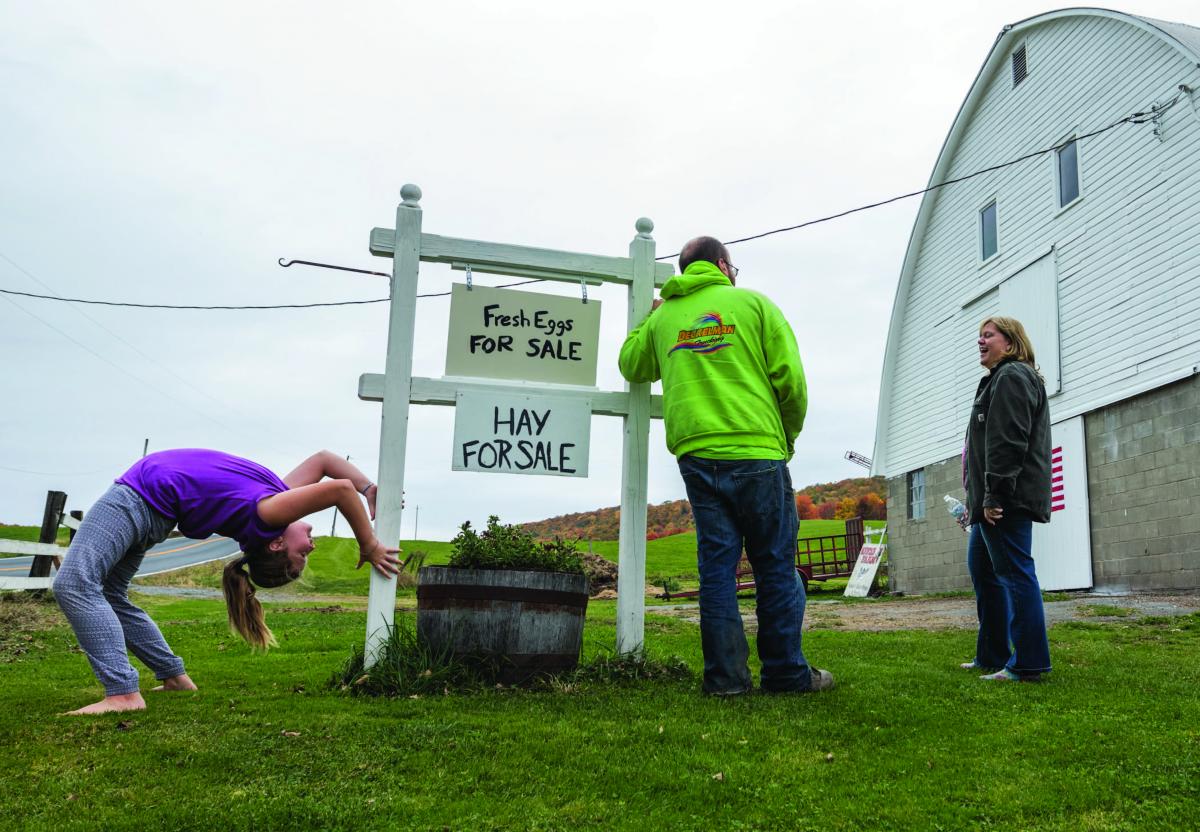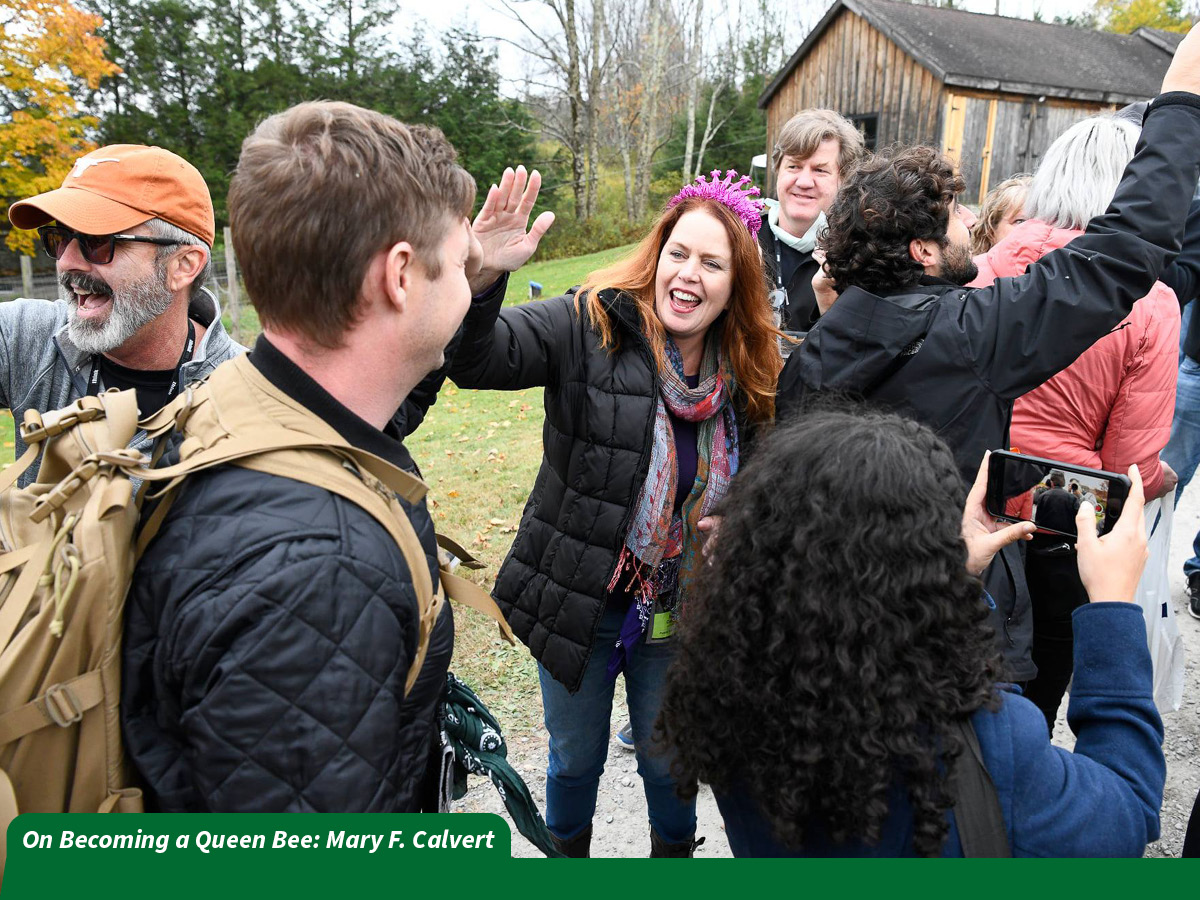
Tiara-bedecked photojournalist Mary F. Calvert introduces herself to the Purple Team at the 32nd Annual Eddie Adams Workshop. (Photo courtesy of the Eddie Adams Workshop)
As I climbed onto a charter bus in the fall of 2019, I found myself awestruck, surrounded by a community of fledgling photographers all traveling in my same direction. We were just minutes away from beginning our fourday immersion into the art and craft of narrative photojournalism. My months of daydreaming and planning were about to be realized as we pulled into the pastoral setting of Sullivan County, New York and one of the country’s premier weekend photography workshops, the Eddie Adams Workshop, then in its 32nd year.
Sitting next to me on the bus was a female photographer with platinumbobbed hair, Josephine Norris, who was about my age but definitely more well informed. I told her that I received an email from the workshop telling me I was on the Purple Team, and the Purple Team leader was someone named Mary F. Calvert. My bus-mate’s eyes seemed to light up with envy, which made me more trepidatious than usual. She informed me that Mary’s work would soon inspire me to view photojournalism under an entirely new lens. I had only had two years of photojournalism classes at the University of North Texas in Denton. What if I wasn’t good enough, talented enough – what if I wasn’t up to her high standards? But then I recalled the Eddie Adams website and what drew me to apply in the first place:
“Applicants at the start of their career submit portfolios for consideration. One hundred participants selected solely on the merit of their pictures team up with top professional photographers and editors for a four-day gathering that includes assignments, portfolio reviews, panel discussions and presentations.”
I was at the start of my career; I had submitted my portfolio; I was selected along with 99 other applicants based on the merit of my photos. I needed to buck up.
So, I got off the bus, drank in the fresh country air, grabbed my overstuffed camera backpack and headed up a gently sloping hill where I was greeted, summer-camp like, by a sea of high-fives and cheers while live music played in the background. There would be 10 groups, with each group assigned a different bright color: yellow, green, pink, red, green, blue—among them. I searched for the color purple, but was interrupted by a man in a hoodie and baseball cap. “Purple Team,” he shouted. “Meet by the large rock near the barn.” It was our team producer, The New York Times business photo editor, Brent Lewis.
I made my way over the freshly cut grass as I dodged yellow jackets and spiders. Suddenly, I was surrounded by 13 people sporting deep-purple bandanas. Sitting across from me was a woman with long, red hair and tired blue eyes. She adjusted the plastic magenta tiara on her head and introduced herself to the group as Mary F. Calvert. Wasting no time, she dismissed any notion that we were there to network, to somehow schmooze our way to the top. Instead we were there to “document life” and our assignment was to document the “Queen Bees” of Sullivan County, an homage to the courageous women who lived in the area. Teamed with a photographer from Montreal, I would be photographing three generations of women who owned a family farm.
Mary continued her lecture until late into the night—she was nothing if not relentless. It was nearing 3 a.m. when I retreated to my lumpy mattress at the Knights Inn, my mind flooded with photojournalism advice. Despite my droopy eyes, I felt drawn to the glow of my cell phone. If I wanted to learn from the best, I needed to understand why she was considered the best. An extensive Google search revealed that she is a three-time Pulitzer Prize finalist in Feature Photography, her most acclaimed work garnering her world renown for the seven years she spent documenting the sexual abuse of men and women in the Armed Services. Early in her career, she became a photographer for the Washington Times where she worked for 11 years before the paper laid off its entire photography staff. Undaunted she turned to freelance work, grabbing jobs as a portrait and wedding photographer, anything she could find “to pay the mortgage.” She met with success and began traveling the globe as a photojournalist, documenting images that dealt with neglected human rights issues. Her work has appeared in publications including The New York Times, The Washington Post, Esquire, Elle, Cosmopolitan and The Los Angeles Times.
Her extensive list of awards and achievements impressed me, but what caught my eye was her ability to tell vulnerable stories in a poetic way. I thought back to the sentence she repeated throughout the day. “Photojournalism is not about the photographer. It’s about the subject.” This weekend was more than a social experience, but a time to prove that I was more than a portrait photographer. I drifted off to sleep, feeling inspired and exhausted and ready.
FOG LINGERED IN THE AIR, and I stood shaking like a leaf in front of the barn before the second day began. I had a hard time deciphering if I was chilly or if it was more anxiety bubbling within me. My only photojournalism experience was themed class projects and the photo story of college life for my campus job. Shy and unsure how to fully navigate immersive photojournalism, I had stuck to photographing people from a distance, or safer yet, photographing buildings and signs. At the Eddie Adams Workshop, I felt like I was thrown into the deep end of a pool and forced to learn how to swim. Excited, I finally had a mentor to push me past my comfort zone. Mary wasn’t afraid to “exploit my weaknesses,” and reminded me that we all have to start somewhere.
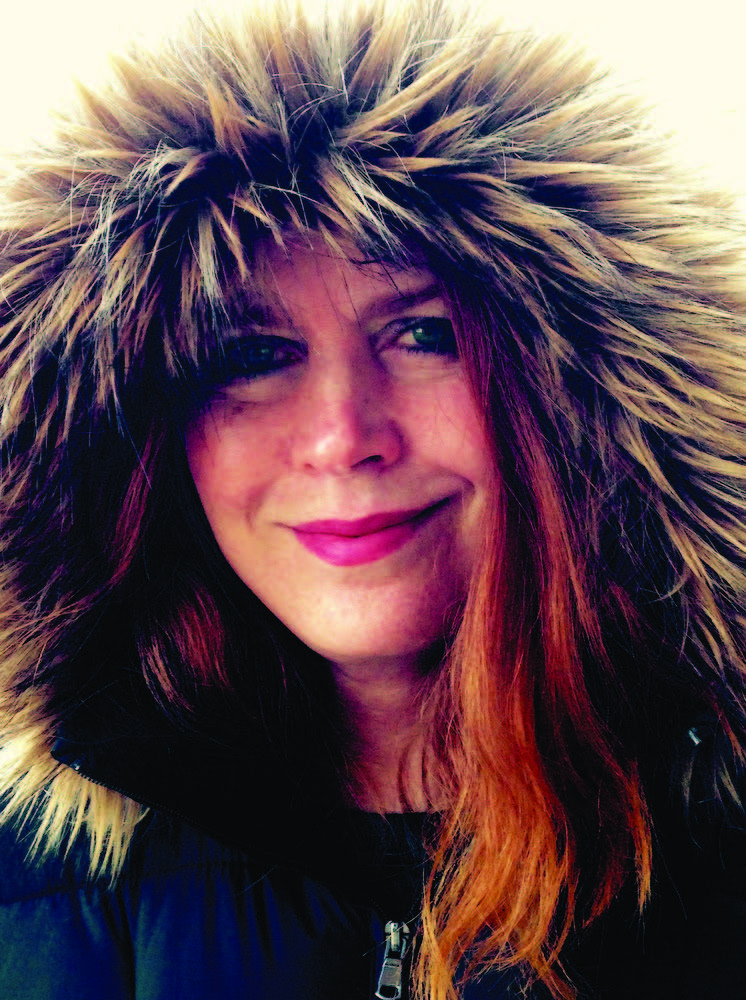 While photojournalism was a relatively new adventure for me, Mary was practically born with a camera in her hand. As a child she enjoyed sculpting and drawing, but photography was where she felt at home. Her father fought in the Korean War and had documented his war experiences, snapping photos of American soldiers and Korean children. When he returned home to Virginia, he spent time with Mary teaching her photography. Plastic Diana cameras were a household staple and she spent much of her teenage years developing photos with her father in the kitchen sink.
While photojournalism was a relatively new adventure for me, Mary was practically born with a camera in her hand. As a child she enjoyed sculpting and drawing, but photography was where she felt at home. Her father fought in the Korean War and had documented his war experiences, snapping photos of American soldiers and Korean children. When he returned home to Virginia, he spent time with Mary teaching her photography. Plastic Diana cameras were a household staple and she spent much of her teenage years developing photos with her father in the kitchen sink.
After shuffling through several college majors, Mary discovered her career path when she heard the breaking news that then-President Ronald Reagan had been shot. She grabbed her camera gear and headed to the Washington D.C. hospital where he had been taken. “For four hours, I basically hung out with the White House press corps and all these photojournalists,” she would later tell me. “It was really crazy, but that’s when I found my life’s work.”
At the workshop, it was lunch time, and we scarfed down tacos as Mary spoke to us about our photo assignments, reminding us of our goal for the weekend–– to capture authentic moments of our Queen Bees – their courage, their spirit, their emotions, their grit. But unlike many photojournalists, our subjects were hand-picked, their consent prearranged, their timing predetermined. My partner and I were even given a crinkled piece of paper with the precise coordinates of the Phelps family farm. But it was up to us to determine what to photograph. It was up to us to find the heart of the story.
Mary claimed no such advantage when she began what would become a seven-year body of work: photographing the survivors of sexual assault in the U.S. military. Her husband gave her the idea, knowing her passion for social issues. But she lacked press credentials and had no sources who could introduce her to any of the 20,000 women and men per year who, according to Pentagon reports, suffer sexual assault in the military.
Research helped, Facebook helped, but cold-calling victims, who were first traumatized by their sexual assaults and then ostracized by the military for reporting it, made it practically impossible to find people willing to be photographed.
Only after Congress began investigating the issue in 2013 did she make any real progress. She attended three sets of hearings on Capitol Hill and became a familiar face to those who wanted Congress to take action. After victims testified, she would approach them. “I asked them if they would be willing to share the most devastating thing that ever happened to them, basically to the world,” she recalled. “So, it took me a long time to get people to talk.” Even if it meant traveling across the country, she offered to come to their homes, to photograph them against the background of their everyday lives. “I found that people were just hungry to tell their story to somebody—somebody who believed them.”
MY TEAMMATE AND I ARRIVED at Mountain Ash Farm at 10 a.m. A handpainted sign announcing that eggs and hay were sold by the Phelps family hung from a large white barn. It felt like we had been dropped into the pages of “Charlotte’s Web”. Acres of rolling hills stretched across the horizon and honey bees buzzed around my ears. I admired the yellow and orange foliage falling from the trees as I smelled the fresh, crisp air. This seemed nothing like my family’s farm in Oklahoma with flat land and clouds of dirt wafting through the air.
An enthusiastic woman with short blonde hair waved from across the gravel road. Her name was Jenny Phelps, the woman I would be photographing for the weekend. She tugged at the sleeves of her Carhartt coat and gestured for us to come inside. It was time to learn about the Phelps family and the generations of farmers who owned and ran the farm.
Mary told me that when she meets her subjects, she interviews them, “collecting a lot of audio and taking a lot of notes.” She then tells them to go about their day as if she weren’t there, cooking dinner, checking emails, going to bed, letting their lives unfold as they revealed themselves in front of her. By immersing herself in their lives, she would gain their trust and would be able to narrate their stories through her photographs, with all its authentic moments of joy and pain.
Mary saw that pain when she arrived at the home of Billy Joe Capshaw in Hot Springs, Arkansas. Paralyzed with fear, Billy stood in the doorway as the stranger with a camera asked to come in. But she didn’t snap photos. She sat and listened to the story of 17-year-old Billy Joe who had enlisted in the U.S. Army to support his family. Stationed in Germany, Billy met his roommate Jeffrey Dahmer who would later be exposed as the infamous serial killer and sex abuser who dismembered the body parts of his victims. On their third night in the barracks, a drunk Dahmer raped Billy Joe – for the first time.
After returning from the army, Billy Ray lived in a two-bedroom apartment but he never slept in a bed. Instead, he spent every night on the living room sofa with a single blanket and the kitchen light on. When Mary asked him why, he said he had been raped repeatedly in a bed in a dark room. The remnants of his trauma lingered in his mind like roaches infesting a home, and Mary wanted to capture that trauma to tell his story. “I thought this was a major trigger for him, Mary would later tell me. “But I thought it was a very important issue to make.” It took several days of building trust but he agreed to let her photograph him sleeping. So, for several nights, she would sit, camera in hand, on his living room floor or the kitchen floor or the balcony, waiting for him to drift off to sleep. One night she finally saw the image she wanted, snapped a few shots and left.
“You might feel afraid or uncomfortable to ask them if you can photograph something—feeling like you don’t want to intrude,” she said. “But to get authentic, intimate pictures, you have to push past whatever emotional barriers you might have.”
I didn’t expect to find any serial killers, or any trauma inflicted by barnyard animals, for that matter, but I did hope to follow the immersive process Mary had outlined for us. Once inside the farmhouse with Jenny, we sat around the kitchen table. I took out my phone and began typing notes as Jenny summarized her family’s life. The mother and daughter had a jam-packed weekend that consisted of collecting eggs, herding cows, and hosting a 5K run. For the Phelps family, motherdaughter time meant giving back to the community in the form of offering fresh eggs and raising funds for local events.
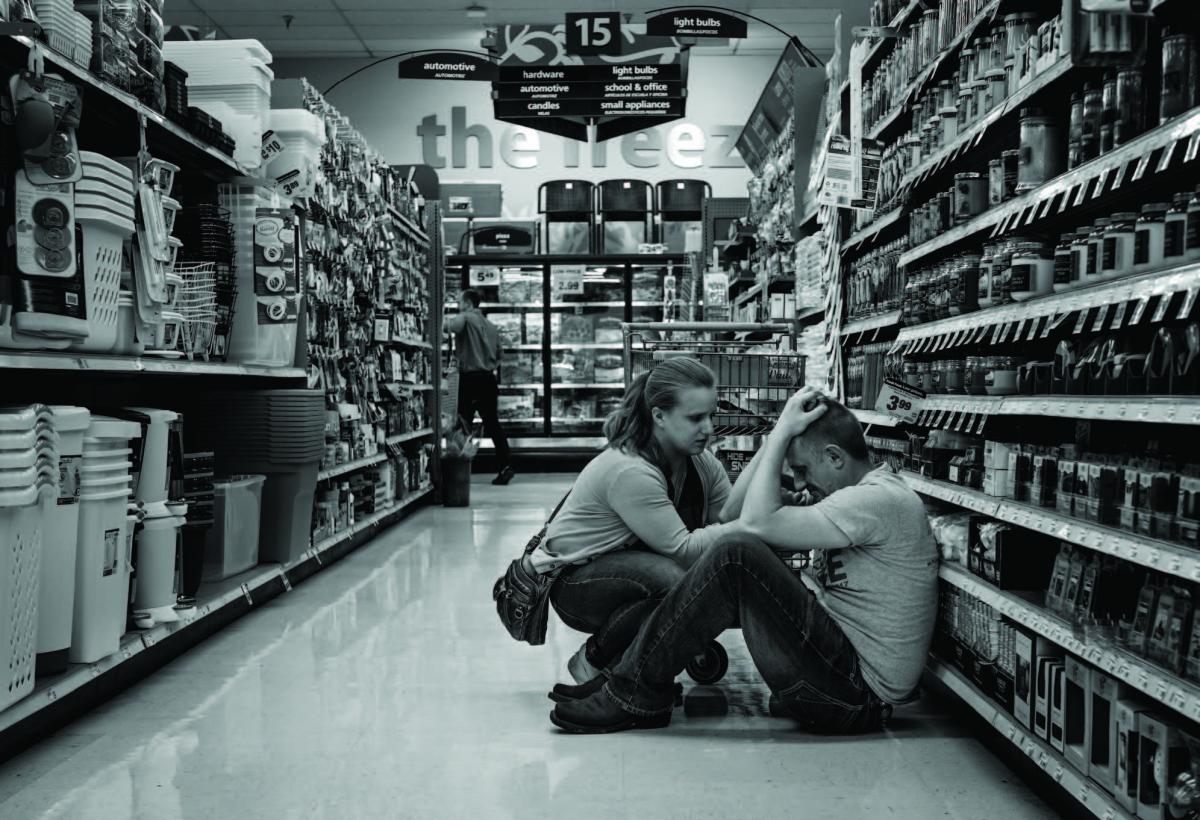
When Mary told the Purple Team about our Queen Bee theme, she mentioned she wanted our photo projects to celebrate strong women everywhere. “From the young ladies to the older women, just get out there and show that being strong doesn’t mean you can lift a lot of stuff. It’s something else entirely.” It was my job as a photojournalist to capture the strength of the Phelps family women.
Jenny suddenly turned to look at the clock, smiled and said, “Let me show you the farm. It’s time to feed the cows.” Following me like a shadow was Jenny’s daughter Maylee. Although shy, the 11-year-old exuded independence when it came time to call the cows. After a couple of clicking sounds and shuffling the bucket of feed, Maylee appeared on top of a hill walking beside two cows.
I heard Mary’s voice buzzing in my head, reminding me to be a fly on the wall. I took a step back and let life unfold as Jenny and Maylee tended to their daily farm chores. Chickens clucked around my feet as I snapped photos of the duo collecting eggs and raking hay. Although these captures had vibrant colors, I patiently waited for emotion. Photos of farm culture featuring snapshots of bunny handling and observing the beehives soon evolved into the relationship between a dedicated mother and her rambunctious daughter. But their giggling and playful energy somehow devolved into bickering about unsorted laundry. Maylee accepted defeat and rested her head on her mother’s shoulder as if to apologize in silence. This was the moment Mary had mentioned. I pressed down the shutter and captured a photo of the tired farm girl resting on her mother as an American flag waved in the background. Between checking on the chickens and the cows, and cartwheels through the fields, Maylee’s energy was directed toward adventure. She had no time for traditional chores like picking up clothes from her floor. My heart fluttered because these were the authentic moments I ached to capture, and what Mary had been preaching to us. This photo was more than a child resting against her mother. It represented the bond between the two. Although occasionally rocky as the adolescent explored life, Maylee knew she could always count on her mother. Jenny’s strength came in the form of the emotional support she gave her daughter. I had found my Queen Bee moment.
TRUST WAS A KEYWORD MARY recited the night before. Photojournalism required trust. The words replayed in my mind while I attempted to sleep for two hours. It was the third day of the Eddie Adams Workshop, and I was still unsure how to build trust with my subjects. I had just met them, and today would be my last day with them.
Where her sexual assault survivors were concerned, Mary had sculpted trust into its own art form. She flew to Salt Lake City to photograph Paul Lloyd who was raped and beaten in 2007 when he was a recruit in the Army National Guard. Lloyd refuses to go to the dentist because he fears strangers getting too close. But he allowed Mary to sleep on his couch for several days to get her images. She would follow Lloyd everywhere, and grew physically tired and emotionally drained after several days of “being on that much,” she would later recall. “And being hyper-aware of everything happening around me.” When Lloyd and his wife decided to drive to the grocery store to pick up dinner, Mary said she would wait in the car to “kick back and zone out.” But suddenly concerned she might not be there to document some authentic moment, she went into the grocery store and observed Lloyd pick up a candle that smelled like the shampoo he had used in the shower when he was raped. She snapped a photo of that flashback moment, as he dropped to the floor, his hands cupping his head, his wife consoling him. “You never know what you’re going to miss, and if I hadn’t [pushed myself], I would not have had him having a flashback in the grocery store.”
Mary’s point: trust creates the kind of access that gives you the opportunity to capture authentic moments. Not only was my access to the Phelps women limited, but after Mary reviewed my photos from the day before, she told me to switch my focus from the mother to the daughter. Maylee had spunk and embodied what it meant to be a leader as a young girl.
I was worried 11-year old Maylee would be apprehensive about a stranger with a camera poking around her life, but I pushed through my concerns, collected my camera gear, and set out to build trust before the sun was up.
I approached the family at a park where Maylee was stacking a tower of Girl Scout cookies like Jenga blocks, and her mother was registering runners for a 5K race, a fundraiser for the local 4-H Club. Maylee’s grandmother also was working the race, manning the breakfast station for prospective runners, serving them bananas and hot coffee.
Maylee greeted me with a wave, and gave me a quick itinerary for the day– sell some cookies, run the 5K, and then go home. Then she turned to greet some friends at the check-in station while I lingered under the pavilion observing Maylee’s interactions. But I felt uneasy because she offered no clue about whether she trusted me. An hour passed and Maylee ran through the finish line with tears streaming down her face. She buried her head into her grandmother’s pink hoodie, and clutched her knee. Maylee had fallen halfway through the course, but was determined to finish and work through the pain, even if that meant straining her muscles.
In just two days, I had documented Maylee as a queen bee-in-waiting. Even though I would photograph her driving in an ATV, playing the piano in her living room, and listening to her mother and grandmother as they sat in cozy den chairs talking about the farm, that image of her crying into her grandmother’s arms was one of my favorites. Rather than wave me off or tell me to go away, she allowed me to capture her at her most vulnerable. I grew convinced that I had gained her trust after all.
DAY FOUR OF MY WEEKEND at the Eddie Adams Workshop arrived, and it was time to present our stories. Mary was known as a tough critic, likely because she expected so much of herself, but the feedback she gave me seemed rather mild. We had accomplished our goal of telling a story, she said, explaining the few technical mistakes I had made in a constructive way that helped me understand I still had room to grow. This was the type of critique I longed for but seldom received. Critique days in class were filled with compliments from my classmates, but never advice on how to advance my storytelling.
Even though my body longed for rest, celebration was in the air this final night of the workshop. The stars twinkled above us as we were called to take our seats in the barn. Mary approached the podium to present the Purple Team’s projects and reminisce about the weekend.
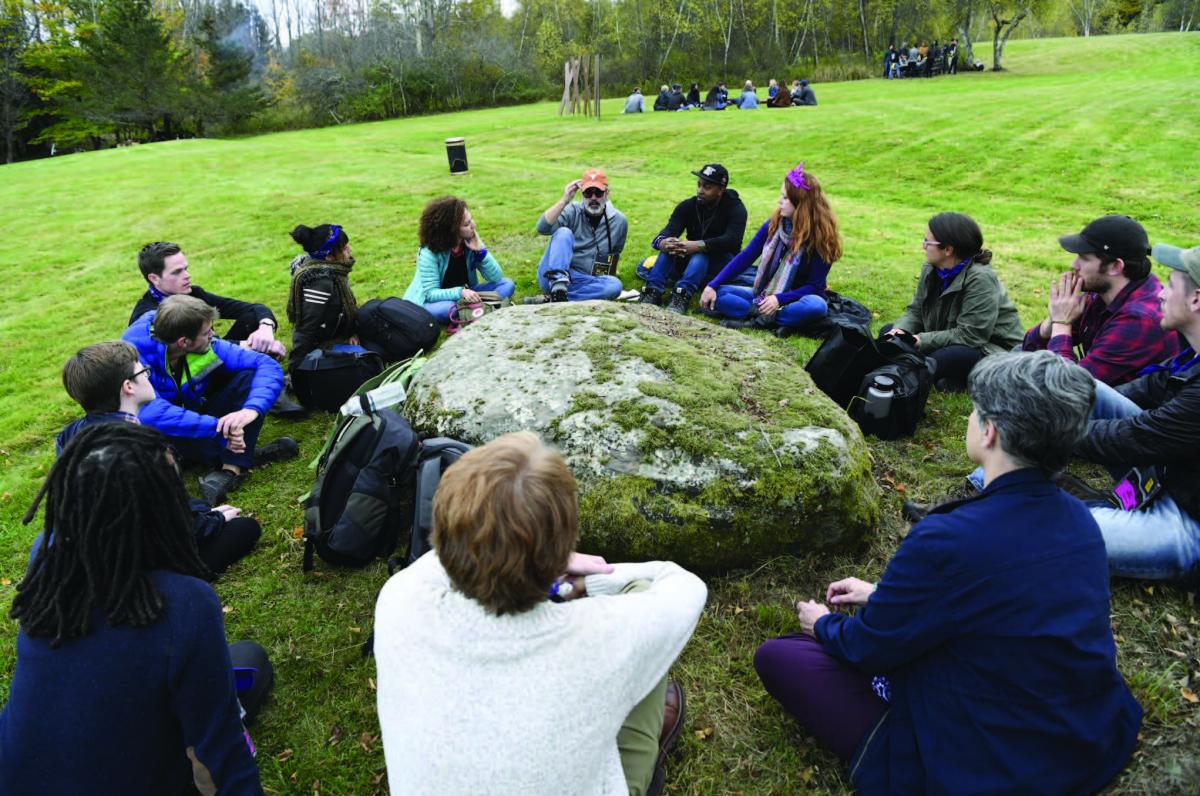
“As Mick Jagger would say, everybody looks a little bleary,” Mary joked.
Sure, we were exhausted. I only had nine hours of sleep in four days. My cameras felt like a ton of bricks and I would have paid good money for a shower and a nap. But that was the price of being a photojournalist. Certainly, there were images from other workshop participants that told more compelling stories than mine, certainly there were photos that captured moments that revealed deeper emotions than mine. But there were things that I learned in those four days –things like how the work requires you to get outside your comfort zone, to break through emotional barriers like shyness and insecurity if you are to gain the trust of your subjects; how you have to sometimes work yourself, to a state of exhaustion, if you hope to be there to document a person’s life. In one weekend, my skin had grown a bit thicker and I had grown a bit stronger in my commitment to becoming a photojournalist. Maybe in some strange way, the workshop had helped me channel my own inner Queen Bee.
